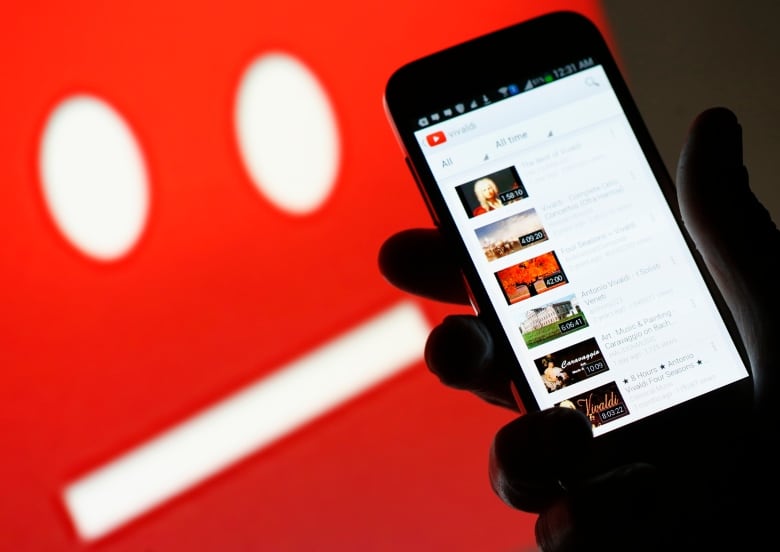YouTube to update 'Content ID,' bringing hope to professional YouTubers
Existing automated copyright-checking system can sometimes unfairly shut down video creators

YouTube's automated Content ID system is meant to catch potential copyright violations almost as soon as they happen.
But as Canadian YouTube star Corey Vidal has learned, Content ID can cause financial and logistical difficulties for people who make YouTube videos for a living — difficulties that may be eased by an upcoming change to how Content ID works.
In 2009, Vidal's popular Star Wars-themed acappella tribute to famed movie score composer John Williams was hit with a copyright violation claim after the Content ID system flagged it as violating a copyright held by Warner Music Group.
At the time, it was Vidal's third "strike" under YouTube's copyright enforcement regime, and he had his YouTube channel suspended.
"I look, and my entire YouTube channel is gone," recalls Vidal. "Literally my entire life was taken away from me in the blink of an eye."
- YouTube video of baby dancing to Prince sparks copyright trial
- YouTube gaming stars hit by Nintendo ad revenue grab
Vidal was able to resolve some of the previous disputes and revive his channel, but it took time to dispute the copyright claim on his video. He estimates that cost him thousands of dollars in potential advertising revenue.
Now, YouTube is promising to reform Content ID in a way that would allow video producers to potentially keep the revenue from disputed videos, by letting videos with potential copyright violations continue earning money while the dispute is resolved. Some YouTube content creators say that's good news for their businesses.
How Content ID works, and how it's changing
YouTube launched Content ID in 2007, within a year of the video service being purchased by Google. Even when it doesn't lead to the deletion of an entire account, the Content ID system can prevent advertising revenue from reaching video creators, if it determines that a video violates existing copyrights.
Certain copyright owners (often movie studios, music labels and video game producers) can submit their copyrighted content to a YouTube database, which assigns each item a digital identifier based on its video and audio attributes. YouTube then scans new videos against that database to check for matches.
I think YouTube is giving content creators a bit of the benefit of the doubt.- Michael Rizzi, YouTube video creator
If the Content ID system finds that a new video uses copyrighted material, it gives the copyright owner options like blocking the video, or even earning advertising revenue from it. If the video's creator disputes the copyright claim, though, YouTube currently suspends all revenue collection from the video until it can resolve the dispute. (YouTube says less than one per cent of Content ID claims are disputed.)
In a blog post YouTube says, "We've been listening closely to concerns about the loss of monetization during the Content ID dispute process" and acknowledges that losing advertising revenue can be "an especially frustrating experience for creators if that claim ends up being incorrect while a video racks up views in its first few days."
Vidal describes YouTube's new plan as "genius" and "perfect."
"I understand the challenge of scale" that YouTube faces, says Vidal. "I understand that Content ID is probably, for the most part, very accurate."
Content misidentification
Even though YouTube's Content ID system might be accurate most of the time, it's clear that there's still room to improve both Content ID and the way YouTube resolves copyright disputes.
British composer Simon Wilkinson writes and licenses ambient music for videos, many of which end up on YouTube.
"There's a huge amount of content creators like myself," says Wilkinson. "I think YouTube are now realizing that there's a growing voice of people that are getting frustrated at the Content ID system."
Over the past six months, Wilkinson says Content ID has repeatedly misidentified one of his more popular tracks as copyrighted material owned by someone else, leading to copyright disputes for video producers who paid to use his music. Wilkinson says the two songs sound nothing alike.
"It makes me look kind of shady, like maybe I've sampled a band or that I'm selling music that isn't mine," says Wilkinson.

Shane Luis, who produces video game-themed videos for the popular YouTube channel Rerez, recently faced a copyright dispute from video game company Konami. He chose to remove the video in question entirely rather than dispute Konami's claim, for fear of earning a strike that would threaten his YouTube account — even though he believed he was using Konami's material legally.
Although Luis says he's learned about relevant copyright law, he thinks many YouTube video creators are entirely unaware of how copyright works, which exacerbates the problem. He'd like to see better communication on YouTube's part regarding what is and isn't legal.
"The conversation has been kind of blank," says Luis. "Nobody really knows what they're allowed to do."
Michael Rizzi, who runs an LGBT-themed YouTube channel, sees YouTube's move to update Content ID as an acknowledgement of the complexity of copyright law.
"I think YouTube is giving content creators a bit of the benefit of the doubt, knowing that these could be 16- to 24-year-olds, or maybe even older, who just have no idea that what they're doing isn't allowed," says Rizzi.